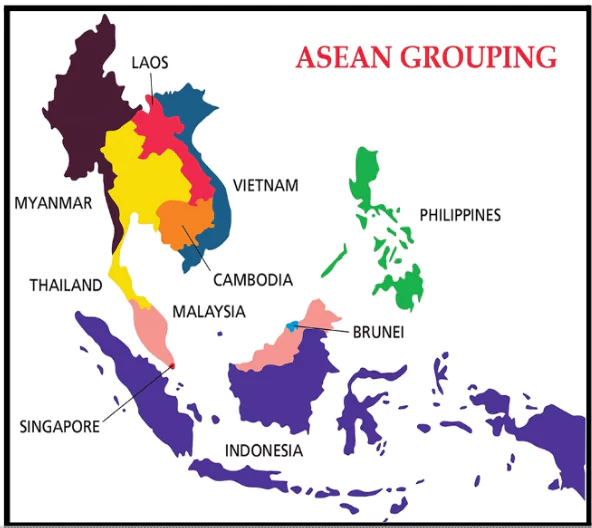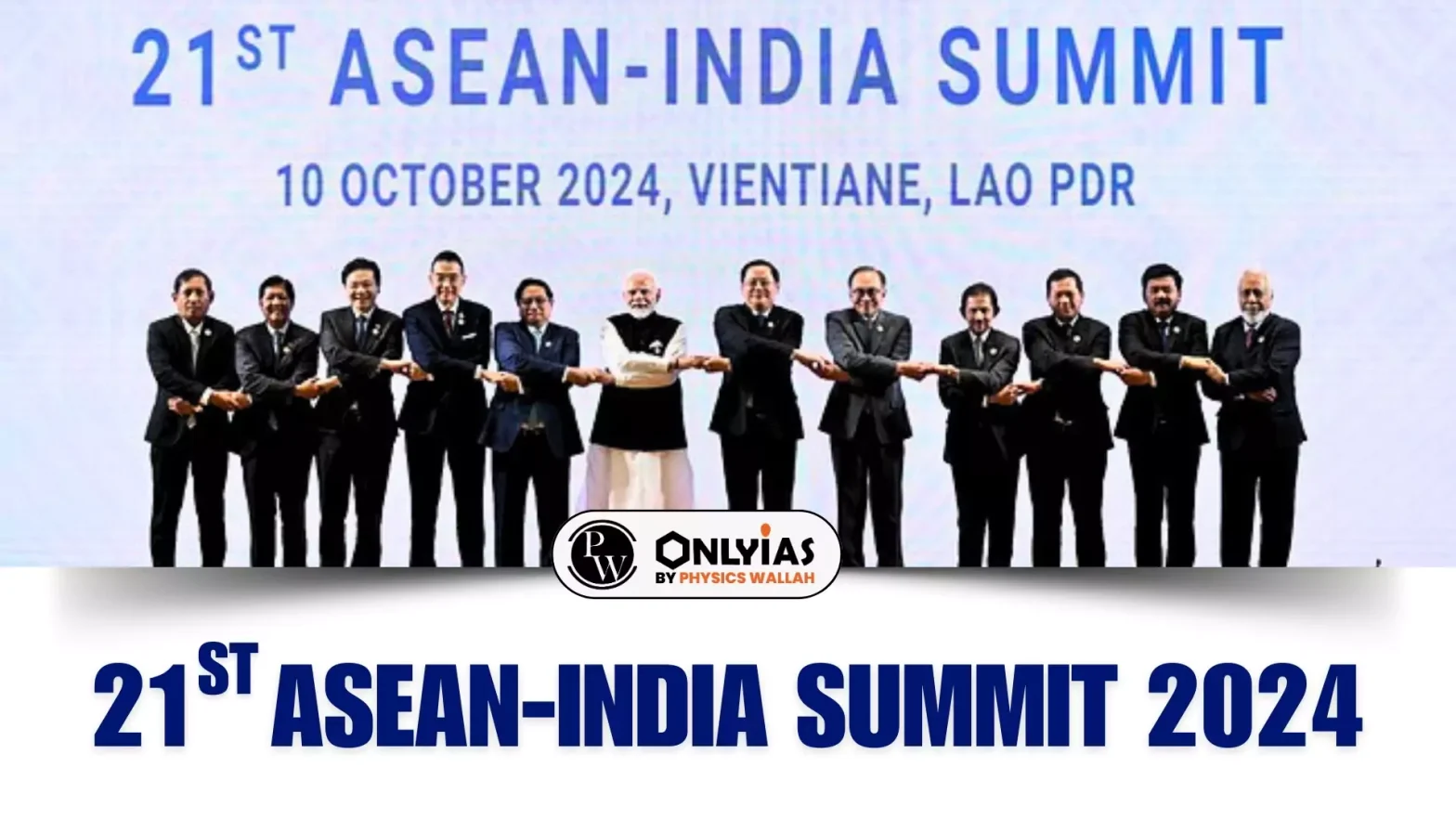Recently, the 21st ASEAN-India Summit was held in Vientiane, Laos.
21st ASEAN-India Summit 2024
The Indian Prime Minister (PM) also attended the 19th East Asia Summit (EAS) on 11 October 2024 in Vientiane, Lao PDR.
- India commemorated the 10th anniversary of its Act East Policy.
Enroll now for UPSC Online Course
Key Highlights of the 19th East Asia Summit
- ASEAN’s Central Role: India emphasised ASEAN’s crucial role in the Indo-Pacific regional framework, aligning with its Indo-Pacific Vision and Quad cooperation.
- Act East Policy: India highlighted its participation in the East Asia Summit (EAS) as a fundamental component of its Act East Policy.
- Development Over Expansionism: A development-oriented approach was advocated, contrasting with expansionist strategies in the region.
- Support for Nalanda University: India expressed gratitude for support in reviving Nalanda University and invited EAS countries to a Heads of Higher Education Conclave there.
- Global Security Challenges: India highlighted terrorism, cyber threats, and maritime challenges as significant global security issues, calling for collective action to address these threats.
- Acknowledgment: India thanked the Prime Minister of Laos for hosting the summit and expressed full support for Malaysia as the new ASEAN Chair.
|
Key Highlights Of the 21st India-ASEAN Summit 2024
- 10-Point Plan: Prime Minister Narendra Modi unveiled a 10-point plan to bolster the ASEAN-India Comprehensive Partnership at the 21st ASEAN-India Summit.
- Maritime Cooperation: ASEAN and India agreed to enhance collaboration between the ASEAN Outlook on the Indo-Pacific (AOIP) and the Indo-Pacific Oceans Initiative (IPOI).
- ASEAN-India Plan of Action: The leaders agreed to create a new ASEAN-India Plan of Action (2026-2030) to realise the full potential of the ASEAN-India partnership
- Counter Terrorism Cooperation: India’s co-chairmanship of the ASEAN Defence Ministers’ Meeting (ADMM)-Plus Experts’ Working Group on Counter-Terrorism for 2024-2027 was highlighted in the Summit.
- Reviewing AITIGA: Both sides emphasised the need to expedite the review of the ASEAN-India Trade in Goods Agreement (AITIGA).
10-Point Plan Announced At The Summit
- 2025 will be celebrated as ASEAN-India Year of Tourism: India will contribute USD 5 million for joint activities.
- Celebrating a Decade of Act East Policy: Activities include a Youth Summit, Start-up Festival, Hackathon, Music Festival, and Delhi Dialogue.
- Delhi Dialogue is an annual track 1.5 event for discussing politico-security and economic issues between Association of Southeast Asian Nations and India.
| The ASEAN-India Science and Technology Development Fund (AISTDF) was initially set up with $1 million in 2008 and later increased to $5 million in 2015 to support collaborative research projects between India and ASEAN member countries. |
- Organising ASEAN-India Women Scientists Conclave: under the ASEAN-India Science and Technology Development Fund (AISTDF).
- Increased Scholarships: Doubling scholarships at Nalanda University and offering new ones for ASEAN students in agricultural universities.
- Review of ASEAN-India Trade Agreement: Set for completion by 2025.
- Enhancing Disaster Resilience: India will contribute USD 5 million for disaster resilience initiatives.
- ASEAN-India Health Ministers’ Track: To build health resilience.
- ASEAN-India Cyber Policy Dialogue: Strengthening digital and cyber resilience.
- Green Hydrogen Workshop: To foster clean energy collaboration.
- ‘Plant a Tree for Mother’ Campaign: Invited ASEAN leaders to participate in the “Plant a Tree for Mother” campaign to enhance climate resilience.
Check Out UPSC CSE Books From PW Store
Evolution of ASEAN-India Dialogue Relations

- Early 1990s: India introduced the Look East policy to strengthen ties with Southeast Asia.
- Initial Growth (1992-2002)
- ASEAN-India Relations began as a sectoral dialogue partnership in 1992, elevated to a full dialogue partnership by 1995.
- First ASEAN-India Summit held in 2002, marking rapid progress in their cooperation.
- Strategic Partnership (2012)
- In 2012, ties were elevated to a Strategic Partnership as ASEAN and India celebrated 20 years of dialogue.
- The ASEAN-India Eminent Persons Group was formed to review and strengthen relations.
- Act East Policy: The Act East policy emphasises a more proactive approach, encompassing not only ASEAN countries but also expanding focus to include other Indo-Pacific nations such as Australia, New Zealand, Japan, and South Korea.
- Comprehensive Strategic Partnership (2022)
- In 2022, both sides established the ASEAN-India Comprehensive Strategic Partnership and celebrated 30 years of mutually beneficial partnership.
About ASEAN – Association of Southeast Asian Nations
- Establishment: 8 August 1967 in Bangkok, Thailand with the signing of the ASEAN Declaration (Bangkok Declaration).
- Founding members: Indonesia, Malaysia, Philippines, Singapore, Thailand.
- Motto: “One Vision, One Identity, One Community”.
- Members: 10 Members:
- Indonesia, Malaysia, Philippines, Singapore, Thailand, Brunei Darussalam (1984), Vietnam (1995), Lao PDR and Myanmar (1997), and Cambodia (1999)
- Chairmanship: Chairmanship rotates annually, based on the alphabetical order of the English names of Member States.
About East Asia Summit (EAS)
- Established: In 2005 as an ASEAN-led initiative.
- Aim: It emphasises openness, inclusiveness, respect for international law, and ASEAN centrality, with ASEAN acting as the driving force.
- Membership: It has 18 members: 10 ASEAN countries (Brunei, Cambodia, Indonesia, Laos, Malaysia, Myanmar, Philippines, Singapore, Thailand, Vietnam) and eight Non ASEAN Member States (Australia, China, India, Japan, New Zealand, South Korea, Russia, and the United States).
|
Significance of India-ASEAN Partnership
- Economic Significance:
- Trade:
- India and ASEAN are major trading partners, with India’s trade with ASEAN accounting for 11% of its global trade.
- India-ASEAN trade had doubled to over USD 130 billion in the past decade.
- The ASEAN-India Free Trade Area (FTA) has increased bilateral trade, and India is ASEAN’s sixth largest trading partner.
- Investments:
- India is ASEAN’s eighth largest source of foreign direct investment (FDI).
- Singapore is India’s largest trade partner in ASEAN and its sixth largest trade partner worldwide.
- Strategic Significance:
- Countering China’s Influence: ASEAN is a key strategic partner for India, particularly amidst rising geopolitical tensions with China.
- Alignment of India’s ‘Act East Policy’ with ASEAN’s Indo-Pacific Outlook: India’s ‘Act East Policy’ and ASEAN’s ‘Outlook on the Indo-Pacific’ share similar visions for ensuring regional stability and security.
- India’s Role in Regional Security: India engages with ASEAN through forums like the East Asia Summit and ASEAN Regional Forum to position itself as a net security provider.
- Regional Connectivity: Key Infrastructure Projects such as India-Myanmar-Thailand Trilateral Highway and Kaladan Multi-Modal Transit Transport Project are vital for enhancing regional connectivity with Southeast Asia.
- They also serve as alternatives to China’s Belt and Road Initiative in the region.
- Defence Collaboration: India and ASEAN have strengthened defence ties through joint military exercises like the ASEAN-India Maritime Exercise and participation in the ASEAN Defense Ministers’ Meeting Plus (ADMM+).
- India views ASEAN as central to its Indo-Pacific strategy for regional security and growth, represented by the SAGAR (Security and Growth for All in the Region) initiative.
- Others:
- Funding and financial assistance: India has supported ASEAN countries through various funds like the ASEAN-India Cooperation Fund, the ASEAN-India S&T Development Fund, and the ASEAN-India Green Fund, aimed at enhancing cooperation in different sectors.
- Education and Research: India has established the ASEAN-India Centre at the Research and Information System for Developing Countries (RIS) to facilitate studies on ASEAN-India relations.
- First Responder in HADR: India has been among the first responders in providing Humanitarian Assistance and Disaster Relief (HADR) to the region.
- Example: India launched Operation Sadbhav to deliver disaster relief to Laos, Myanmar, and Vietnam in response to severe flooding caused by Typhoon Yagi, in line with its long-standing ‘Act East’ Policy.
Check Out UPSC NCERT Textbooks From PW Store
Challenges in India-ASEAN Relations
- Lack of Market Access: Some Indian products do not have market access in ASEAN countries due to factors such as high tariffs and non-tariff barriers.
- The absence of mutual recognition agreements in professional services restricts the mobility of skilled professionals.
- ASEAN Strict Rules of Origin: The India-ASEAN Free Trade Agreement (FTA) has strict rules of origin, making it challenging for Indian exporters to qualify for tariff reductions.
- Misuse of ASEAN FTA: There are reports of goods being rerouted from China through ASEAN countries with minimal value addition, misusing the FTA benefits.
Regional Comprehensive Economic Partnership (RCEP) is an economic agreement between ASEAN members and Free Trade Agreement (FTA) partners.
- Members: 15 member countries, such as China, Japan, New Zealand, South Korea, Australia, and ASEAN nations( Brunei, Cambodia, Indonesia, Laos, Malaysia, Myanmar, the Philippines, Singapore, Thailand, and Vietnam).
|
- Trade Imbalance: India’s trade deficit with ASEAN has more than doubled since the Free Trade Agreement (FTA) was implemented in 2010, particularly in sectors like electronics and machinery due to issues related to implementation, customs procedures, and non-tariff barriers etc.
- India’s Withdrawal from RCEP: India’s decision to withdraw from the Regional Comprehensive Economic Partnership (RCEP) has led to significant economic disappointment among ASEAN members.
- Infrastructure Connectivity Challenges: Physical infrastructure links remain underdeveloped. Example: The India-Myanmar-Thailand Trilateral Highway, has faced significant delays and remains incomplete.
- China Factor: India’s attempts to counterbalance China, such as through the Quad Alliance, receive mixed reactions from ASEAN countries.
- Cooperation has also been affected by China’s claims over the South China Sea (many of which compete with claims of ASEAN members like the Philippines and Brunei) and the issue of military conflict in its member country, Myanmar.
Measures to Improve India-ASEAN Relations
- Recalibrating the ASEAN-India Free Trade Agreement (AIFTA): There is a need to review AIFTA to address trade imbalances and negotiate balanced tariff reductions in key sectors like pharmaceuticals, textiles,and greater market access for services.
- Enhancing Infrastructure Connectivity: Accelerate key projects such as the India-Myanmar-Thailand Trilateral Highway, extending it to Cambodia, Laos, and Vietnam.
- Develop a “Connectivity Master Plan” aligned with ASEAN’s Master Plan on Connectivity 2025, including digital initiatives like the India-ASEAN submarine cable project.
- Boosting Manufacturing Competitiveness: Extend the Production Linked Incentive (PLI) scheme to boost competitiveness in industries critical for ASEAN trade.
- Expanding QUAD to QUAD+: The concept of the Quadrilateral Security Dialogue (QUAD) should be expanded to include ASEAN countries, creating a QUAD+ arrangement.
- Expanding Semiconductor Diplomacy in ASEAN: India should expand its semiconductor diplomacy with Malaysia and Singapore to include other ASEAN nations, enhancing collaborations in semiconductor manufacturing.
- Strengthening Cultural Connections: via Tourism, Collaborative productions in cinema, music, and television, Offering language courses for ASEAN languages in India and vice versa , etc can deepen relations.
Enroll now for UPSC Online Classes
Conclusion
The India-ASEAN relationship, marked by strong trade and cultural ties can ensure mutual prosperity and stability in Asia.
![]() 11 Oct 2024
11 Oct 2024


